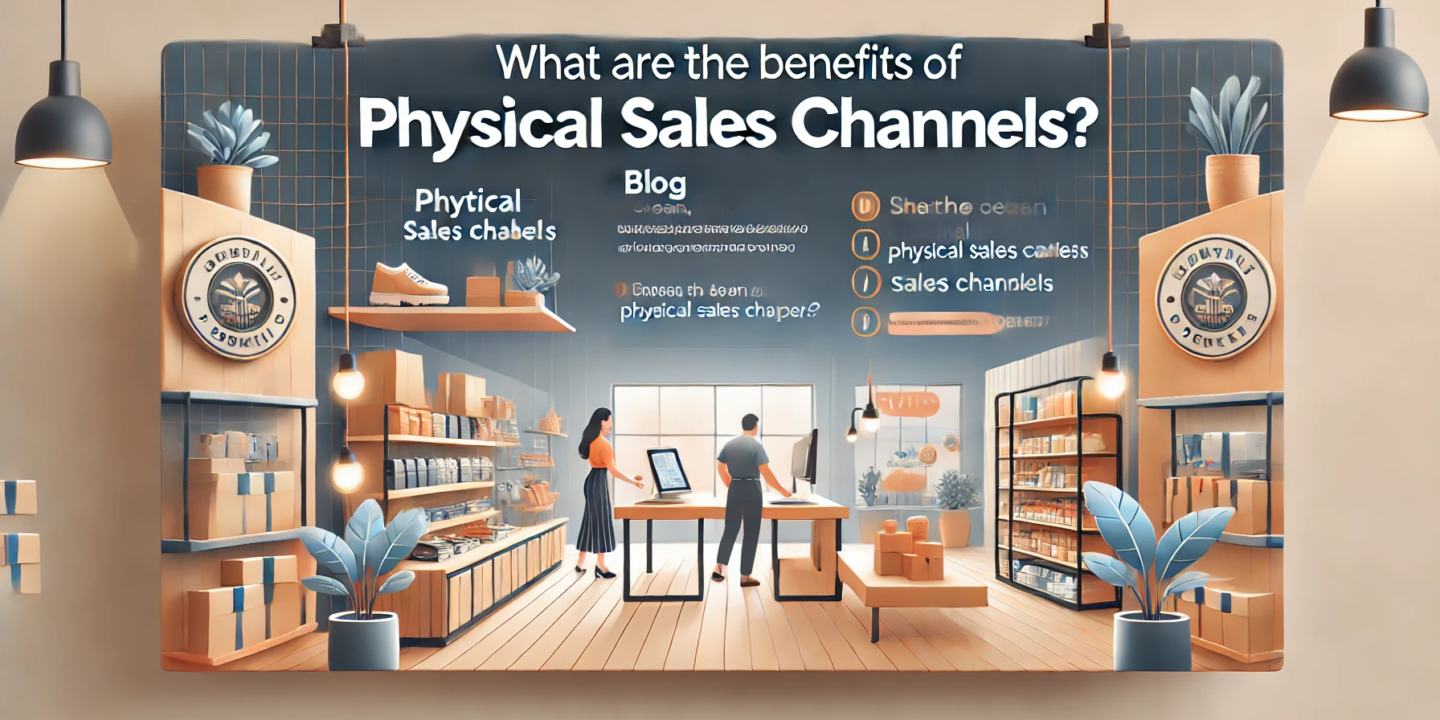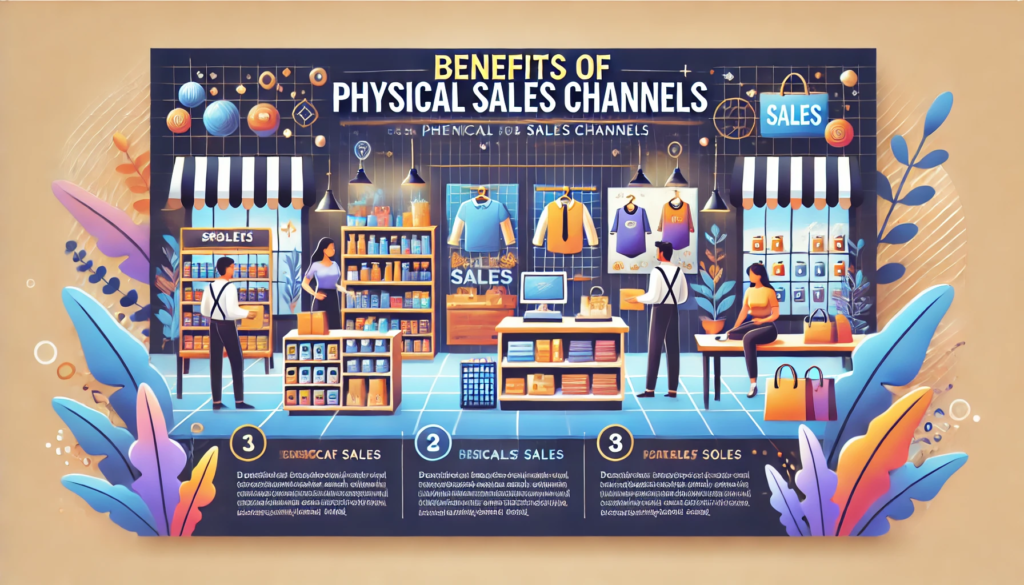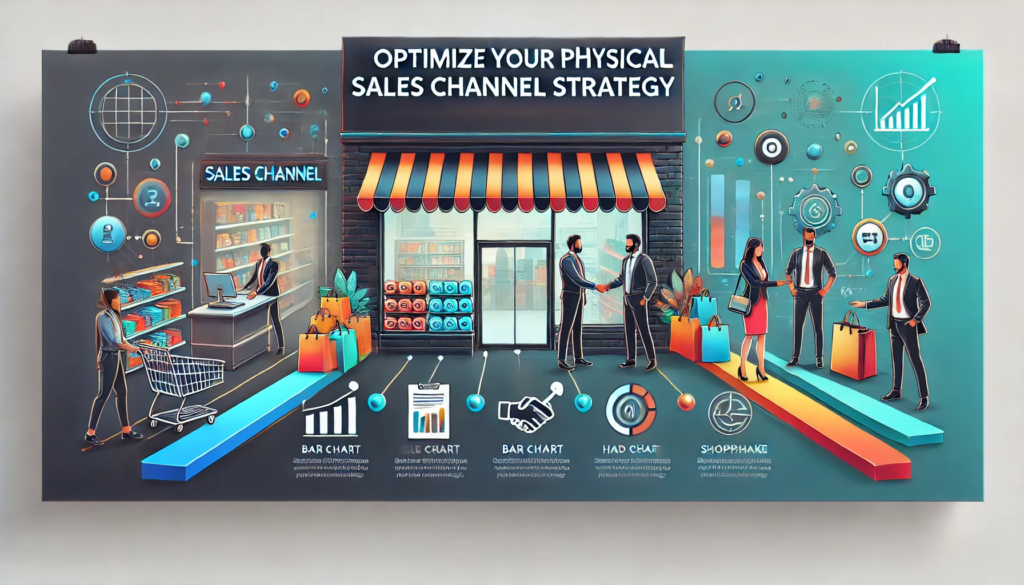
In an era dominated by digital transactions and e-commerce platforms, the value of physical sales channels often gets overshadowed. However, brick-and-mortar stores, pop-up shops, and other offline sales methods still hold significant importance in retail. Physical sales channels offer unique advantages that digital platforms can only sometimes replicate, such as direct customer engagement, tangible product experiences, and immediate satisfaction.
In this blog, “What Are the Benefits of Physical Sales Channels?” we delve into the significant advantages of incorporating physical sales channels into your business strategy. Whether you’re a small business owner or a large retailer, understanding the power of in-person sales can enhance your overall market presence and customer relationships.
Introduction to Physical Sales Channels

Physical sales channels refer to traditional, brick-and-mortar methods of selling products and services. Unlike digital or online, physical sales channels involve face-to-face interactions and direct transactions between the seller and the customer. These channels are crucial in many businesses’ overall sales strategy, providing tangible touchpoints for customers to experience products firsthand.
Different Types of Physical Sales Channels
Retail Stores:
- Overview: Retail stores are the most common form of physical sales channels. They range from small boutiques to large department stores and supermarkets.
- Advantages: Customers can physically inspect products, try them on, and receive immediate gratification upon purchase.
- Challenges: Higher overhead costs due to rent, utilities, and staffing.
Pop-Up Shops:
- Overview: Temporary retail spaces that allow businesses to test new markets, launch products, or capitalize on seasonal demand.
- Advantages: Flexibility, lower long-term costs, and the ability to create buzz and excitement.
- Challenges: Limited time frame and potentially less brand recognition.
Wholesale Distributors:
- Overview: Businesses that purchase products in bulk from manufacturers and sell them to retailers or other wholesalers.
- Advantages: Can handle large volumes of products and have established networks of buyers.
- Challenges: Lower profit margins compared to direct retail sales.
Direct Selling:
- Overview: Involves selling products directly to consumers through personal interactions, such as door-to-door sales, home parties, or personal demonstrations.
- Advantages: Personalized customer experience and direct feedback.
- Challenges: Requires a significant time investment and skilled sales personnel.
Trade Shows and Exhibitions:
- Overview: Events where businesses showcase their products to potential buyers, partners, and industry professionals.
- Advantages: Opportunities for networking, brand exposure, and immediate sales.
- Challenges: High costs for participation and the need for thorough preparation.
What Are the Benefits of Physical Sales Channels?

Here are the top 10 benefits of physical sales channels highlighting their ongoing relevance and importance in today’s market.
Personal Interaction and Relationship Building
Personal Touch: One of the most significant advantages of physical sales channels is the face-to-face interaction with customers. This personal interaction helps build strong relationships, fostering trust and loyalty. Sales associates can immediately provide personalized recommendations and address customer concerns, enhancing the overall customer experience.
Customer Insight: In-person interactions allow sales staff to gather valuable insights about customer preferences, behaviors, and feedback, which can be used to tailor products and services better.
Sensory Experience
Tangible Product Experience: Physical stores allow customers to see, touch, and try products before purchasing. This sensory experience can be crucial, especially for products with essential texture, fit, or quality, such as clothing, furniture, or electronics.
Enhanced Decision Making: The ability to physically interact with products can reduce the hesitation and uncertainty that sometimes accompanies online shopping, leading to more confident purchasing decisions.
Immediate Gratification
Instant Purchase: Unlike online shopping, where customers must wait for shipping, physical sales channels allow for immediate purchase and possession of products. This instant gratification can be a significant advantage, particularly for customers who need items urgently or prefer not to wait.
Reduced Returns: When customers can see and try products before buying, the likelihood of returns decreases as they are more certain about their purchases.
Brand Presence and Visibility
Physical Brand Representation: A physical store helps establish and reinforce a brand’s presence in a community. It is a tangible brand representation, making it more memorable and recognizable to customers.
Foot Traffic: Physical locations can attract foot traffic from passersby who may have yet to discover the brand online. Strategic location choices can lead to increased exposure and spontaneous purchases.
Customer Service Excellence
Personalized Assistance: In physical stores, customers can receive immediate assistance from knowledgeable staff. This customized service can solve problems on the spot and enhance customer satisfaction.
Building Trust: Direct interaction with staff can build trust and credibility, as customers feel more assured when asking questions and receiving immediate, honest answers.
Cross-Selling and Upselling Opportunities
In-Store Promotions: Physical stores provide ample opportunities for cross-selling and upselling. Sales associates can suggest complementary products or upgrades, increasing the average transaction value.
Impulse Buys: Strategically placed items near checkout counters or throughout the store can encourage impulse buys, boosting sales.
Community Engagement
Local Events and Sponsorships: Physical stores can host events, sponsor local activities, and participate in community initiatives. This engagement helps build a positive reputation and fosters a sense of community around the brand.
Customer Loyalty: Being active in the community can increase customer loyalty, as people tend to support businesses that contribute positively to their local area.
Competitive Advantage
Differentiation: Physical stores can differentiate themselves from online-only competitors by offering unique in-store experiences, exclusive products, and exceptional customer service.
Market Penetration: Physical stores can help a brand penetrate markets with limited internet access or where customers prefer traditional shopping experiences.
Omni-Channel Synergy
Seamless Integration: A physical presence can complement online sales channels, creating a seamless omni-channel experience. Customers can enjoy the convenience of browsing online and purchasing in-store or vice versa.
Click-and-Collect: Physical stores enable services like click-and-collect, where customers order online and pick up in-store. This service combines the convenience of online shopping with the immediacy of in-store pickup.
Controlled Environment and Experience
Brand Control: Physical stores completely allow brands to control the environment and customer experience. Everything from store layout to lighting and music can be tailored to create a specific ambiance that aligns with the brand’s identity.
Enhanced Security: Physical stores provide better security for high-value items compared to shipping these items directly to customers, reducing the risk of theft or damage during transit.
How to Optimize Your Physical Sales Channel Strategy?

Optimizing your physical sales channel strategy is crucial for maximizing reach and profitability. Here are key points to consider:
- Understand Your Market: Conduct thorough market research to identify your target audience and their buying behaviors. This helps tailor your strategy to meet their needs.
- Location Selection: Choose strategic locations for your physical stores based on customer demographics, foot traffic, and proximity to competitors. High-traffic areas can significantly boost sales.
- Inventory Management: Implement efficient inventory management systems to ensure that popular products are always in stock while minimizing excess inventory. This reduces costs and improves customer satisfaction.
- Staff Training: Invest in regular training for your sales staff. Knowledgeable and friendly staff can enhance the customer experience, leading to higher conversion rates and customer loyalty.
- Omnichannel Integration: Integrate your physical and online sales channels. Ensure seamless customer experiences across all touchpoints, such as offering in-store pickup for online orders.
- Visual Merchandising: Create attractive store layouts and displays to attract customers and encourage purchases. Effective visual merchandising can significantly impact sales.
- Customer Feedback: Collect and analyze customer feedback to identify areas for improvement. Use this data to refine your sales strategies and improve overall customer satisfaction.
- Promotions and Incentives: Implement targeted promotions and loyalty programs to attract and retain customers. Special offers, discounts, and rewards can drive sales and build customer loyalty.
- Technology Integration: Utilize technology like point-of-sale systems, customer relationship management (CRM) software, and data analytics to streamline operations and gain insights into sales trends.
Physical Sales Channels: Challenges and Opportunities
Challenges:
- High Operating Costs:
- Rent and Utilities: Maintaining a physical storefront involves significant rent, utilities, and maintenance costs.
- Staffing: Hiring, training, and retaining staff is costly and can impact the bottom line.
- Inventory Management:
- Stock Management: Balancing inventory to avoid stockouts or overstock situations requires careful planning and management.
- Storage Costs: Physical space for inventory storage incurs additional costs.
- Geographical Limitations:
- Limited Reach: Physical stores can only serve customers within a specific geographic area, limiting market reach compared to online stores.
- Market Saturation: Competition is often intense in high-demand areas, making it difficult to stand out.
- Changing Consumer Behavior:
- Shift to Online Shopping: Consumers increasingly prefer the convenience of online shopping, which can reduce foot traffic in physical stores.
- Expectations for Omnichannel Experiences: Customers expect seamless integration between online and offline channels, requiring investment in technology and infrastructure.
- Economic Uncertainty:
- Fluctuating Sales: Economic downturns can significantly impact consumer spending and physical store sales.
- Cost Variability: Costs for raw materials, transportation, and other essentials can fluctuate, affecting profitability.
Opportunities:
- Enhanced Customer Experience:
- Personal Touch: Physical stores offer face-to-face interactions, allowing for personalized customer service and immediate feedback.
- In-Store Experiences: Opportunities to create unique, immersive shopping experiences that can’t be replicated online.
- Brand Presence and Loyalty:
- Tangible Connection: A physical presence can help build brand recognition and trust among local customers.
- Loyalty Programs: In-store loyalty programs can drive repeat business and customer retention.
- Local Market Penetration:
- Community Engagement: Physical stores can engage with the local community through events, sponsorships, and partnerships.
- Localized Marketing: Tailoring marketing efforts to the local market can drive traffic and sales.
- Omnichannel Integration:
- Click-and-Collect: Offering services like buy online, pick up in-store (BOPIS) combines the convenience of online shopping with the immediacy of in-store pickup.
- Unified Inventory Systems: Integrated systems can streamline operations, reduce costs, and enhance the customer experience.
- Impulse Purchases:
- In-Store Promotions: Physical stores can capitalize on impulse buying through strategic product placement and in-store promotions.
- Cross-Selling Opportunities: Staff can suggest additional products, increasing the average transaction value.
- Physical Showrooms:
- Product Demonstrations: Providing customers with the opportunity to see, touch, and try products can drive sales, especially for high-ticket items.
- Instant Gratification: Immediate product availability satisfies customer desire for instant gratification.
Future Trends in Physical Sales Channels
The future of physical sales channels is evolving rapidly in response to technological advancements, changing consumer behaviors, and the integration of digital and physical shopping experiences. Here are some key trends to watch for:
- Omnichannel Integration: Retailers increasingly adopt omnichannel strategies, seamlessly integrating online and offline experiences. This approach ensures customers enjoy a consistent and personalized shopping experience across all touchpoints.
- Experiential Retail: Physical stores are transforming into experience centers, offering unique, interactive, and immersive experiences that cannot be replicated online. This trend aims to increase foot traffic and foster brand loyalty by creating memorable shopping experiences.
- Sustainability and Ethical Practices: Consumers are becoming more environmentally conscious, pushing retailers to adopt sustainable practices. These include using eco-friendly materials, reducing waste, and offering ethically sourced products. Transparency in these practices is also crucial.
- Technological Advancements: The incorporation of technologies like augmented reality (AR), virtual reality (VR), and artificial intelligence (AI) is revolutionizing the shopping experience. AR and VR enable customers to visualize products in their environment, while AI enhances personalized recommendations and customer service through chatbots and smart assistants.
- Click-and-Collect Services: The rise of click-and-collect services, where customers order online and pick up in-store, is bridging the gap between e-commerce and physical retail. This model provides convenience and flexibility, catering to the modern consumer’s desire for quick and efficient shopping solutions.
- Smaller Format Stores: Retailers are experimenting with smaller, more agile store formats in urban areas and high-traffic locations. These stores focus on curated selections and serve as pickup points for online orders, maximizing efficiency and customer convenience.
- Data-Driven Decision Making: Retailers leverage big data analytics to understand consumer preferences and behaviors. This data-driven approach allows for more targeted multichannel marketing, optimized inventory management, and improved overall store performance.
Frequently Asked Questions
Q1. What is a physical sales channel?
Ans. A physical sales channel involves selling products or services through traditional, in-person methods. These channels require physical locations, such as retail stores, pop-up shops, or trade shows, where customers can interact directly with products and sales representatives.
Q2. Which two examples are examples of physical sales channels?
Ans. Examples of physical sales channels include brick-and-mortar retail stores, where customers can browse and purchase products, and trade shows, where businesses showcase their offerings to potential buyers and industry professionals.
Q3. What are the four types of sales channels?
Ans. The four types of sales channels are direct sales (e.g., company-owned stores), indirect sales (e.g., distributors), online sales (e.g., e-commerce websites), and retail sales (e.g., department stores). These channels help businesses reach different customer segments and market their products effectively.
Q4. What are the benefits of physical sales channels?
Ans. The benefits of physical sales channels include personal customer interactions, immediate product availability, the ability to provide in-person customer service, and the opportunity to physically inspect products before purchasing, which can enhance customer trust and satisfaction.
Q5. What are physical channels in business?
Ans. Physical channels in business refer to tangible methods of distributing products or services, such as retail stores, wholesalers, and direct sales teams. These channels facilitate the direct exchange of goods between businesses and consumers, enhancing the overall buying experience.
Q6. Which type of physical channel is selling directly to consumers?
Ans. The type of physical channel selling directly to consumers is direct sales. This includes company-owned retail stores, pop-up shops, and door-to-door sales, where businesses engage directly with customers without intermediaries.
Conclusion
Physical sales channels offer numerous benefits, enhancing customer experience through personalized service and immediate product access. They build trust by allowing customers to see and touch products before purchase, fostering stronger brand loyalty. Additionally, these channels provide opportunities for upselling and cross-selling, increasing revenue. They cater to customers who prefer in-person shopping and support local economies. Physical stores also serve as brand ambassadors, creating a tangible presence in the market. In essence, they complement online channels, offering a comprehensive shopping experience that combines convenience, trust, and personal interaction for customers.








No Comments